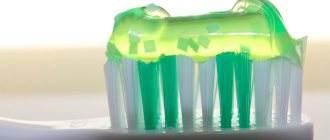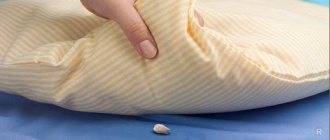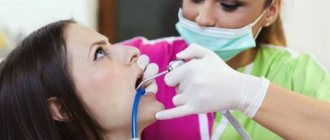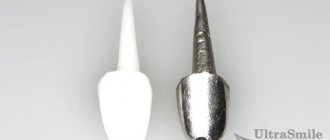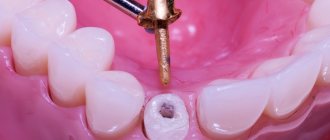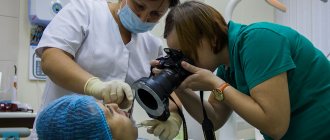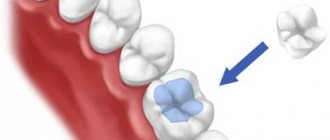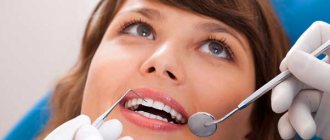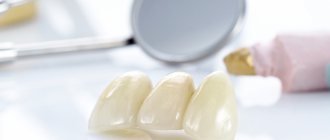What do plaques look like?
The formation of dental plaques on the enamel is represented by a dark or light coating. They negatively affect the overall condition of teeth and can result in tooth loss.
This condition is primarily due to the fact that a huge number of pathogenic microorganisms and their metabolic products have accumulated in the oral cavity at this time.
Question 2. (continued) Dental plaque. Composition and mechanism of formation.
Dental plaque
- a collection of bacteria that are tightly fixed on the surface of the tooth and are capable, under certain conditions, of creating an acidic environment in a limited area of enamel. This is a soft, TRANSPARENT, sticky material consisting of bacteria and their metabolic products, DOES NOT CONTAIN FOOD RESIDUE, AND CANNOT BE REMOVED WITH A REGULAR TOOTHBRUSH.
Plaque growth
:
- Within 2 hours after professional oral hygiene, a pellicle forms on the surface of the enamel.
- Microorganisms that have the ability to selectively attach to hydroxyapatite and pellicle (STREPTOCOCCIS - STR.SANGUIS, ACTINOMYCETES, PEPTOSTREPTOCOCCI) are fixed on the tooth surface. During this period, the plaque mainly consists of aerobic colonies of microorganisms (immature plaque).
- Within 3 days, the “maturation” of the plaque occurs - the growth of anaerobic colonies (STR.MUTANS). From this time on, the sucrose found in dental plaque as a result of glycolysis is converted into a large amount of lactic acid, the pH value reaches 5.5-5.0.
The mechanism of formation of dental plaque
Most often, such formations form on the back walls of the teeth. The negative impact results in demineralization and the formation of caries.
Fissures and blind pits are most susceptible to plaque from dental plaque. Plaque can also spread over smooth parts that come into contact with the root surface during motor activity. Large accumulations of parasites most often form in areas where it is difficult to carry out complete cleaning.
MICROFLORA OF DENTAL PLAQUE
Lecture 5
1. Definition of dental plaque. 2. Mechanisms of formation of dental plaques. 3. Factors in the formation of dental plaque. 4. The role of oral streptococci in the qualitative transition from dental plaque to dental plaque. 5. Localization of dental plaque. Features of microflora, role in pathology.
1. Definition of dental plaque. Dental plaque is an accumulation of bacteria in a matrix of organic substances, mainly proteins and polysaccharides, brought there by saliva and produced by the microorganisms themselves. Plaques are tightly attached to the surface of the teeth. Dental plaque is usually the result of structural changes in the dental plaque, an amorphous substance that fits tightly to the surface of the tooth and has a porous structure, which allows saliva and liquid food components to penetrate into it. The accumulation of final metabolic products of microorganisms and mineral salts in plaque (Mineral salts are deposited on the colloidal basis of the tumor, greatly changing the relationship between mucopolysaccharides, microorganisms, salivary bodies, desquamated epithelium and food debris, which ultimately leads to partial or complete mineralization of the tumor.) slows down this diffusion, since its porosity disappears. As a result, a new formation arises - dental plaque, which can only be removed by force and even not completely.
2. Mechanisms of formation of dental plaques. The formation of dental plaque on smooth surfaces has been extensively studied in vitro and in vivo. Their development follows the general bacterial sequence of microbial community formation in the oral ecosystem. The process of plaque formation begins after brushing the teeth with the interaction of salivary glycoproteins with the tooth surface, with the acidic groups of glycoproteins combining with calcium ions, and the basic ones interacting with hydroxyapatite phosphates. Thus, on the surface of the tooth, as shown in Lecture 3, a film consisting of organic macromolecules, called a pellicle, is formed. The main components of this film are components of saliva and gingival crevicular fluid, such as proteins (albumin, lysozyme, proline-rich proteins), glycoproteins (lactoferrin, IgA, IgG, amylase), phosphoproteins and lipids. Bacteria colonize the pellicle within the first 2-4 hours after brushing. The primary bacteria are streptococci and, to a lesser extent, neisseria and actinomycetes. During this period, bacteria are weakly bound to the film and can be quickly removed by a flow of saliva. After initial colonization, the most active species begin to grow rapidly, forming microcolonies that penetrate the extracellular matrix. Then the process of bacterial aggregation begins and at this stage the constituent components of saliva are connected.
The first microbial cells settle in the depressions on the tooth surface, where they multiply, after which they first fill all the depressions and then move to the smooth surface of the tooth. At this time, along with cocci, a large number of rods and filamentous forms of bacteria appear. Many microbial cells themselves are unable to attach directly to the enamel, but can settle on the surface of other bacteria that have already adhered, i.e. the coadhesion process is underway. The settling of cocci along the perimeter of filamentous bacteria leads to the formation of
called "corn cobs".
The adhesion process occurs very quickly: after 5 minutes, the number of bacterial cells per 1 cm2 increases from 103 to 105 - 106. Subsequently, the adhesion rate decreases and remains stable for about 8 hours. After 1-2 days, the number of attached bacteria increases again, reaching a concentration of 107 - 108. ZN is formed.
Consequently, the initial stages of plaque formation are the process of formation of pronounced soft plaque, which is formed more intensively with poor oral hygiene.
3. Factors in the formation of dental plaque. In the bacterial community of dental plaque there are complex, complementary and mutually exclusive relationships (coaggregation, production of antibacterial substances, changes in pH and ORP, competition for nutrients and cooperation). Thus, oxygen consumption by aerobic species promotes the colonization of obligate anaerobes, such as bacteroides and spirochetes (this phenomenon is observed after 1-2 weeks). If the dental plaque is not subjected to any external influences (mechanical removal), then the complexity of the microflora increases until the maximum concentration of the entire microbial community is established (after 2-3 weeks). During this period, an imbalance in the dental plaque ecosystem can already lead to the development of oral diseases. For example, unrestricted development of subgingival plaque in the absence of oral hygiene can cause gingivitis and subsequent colonization of the subgingival crevice by periodontal pathogens. In addition, the development of dental plaque is associated with certain external factors. Thus, high carbohydrate consumption can lead to more intense and rapid colonization of plaques by S. mutans and lactobacilli.
4. The role of oral streptococci in the qualitative transition from dental plaque to dental plaque. Oral streptococci play an important role in the formation of dental plaques. S.mutans is of particular importance, since these microorganisms actively form tumors, and then plaques on any surfaces. S.sanguis plays a certain role. Thus, during the first 8 hours, the number of S.sanguis cells in plaques is 15-35% of the total number of microbes, and by the second day - 70%; and only then their number decreases. S.salivarius is detected in plaques only during the first 15 minutes, its amount is insignificant (1%). There is an explanation for this phenomenon (S.salivarius, S.sanguis are acid-sensitive streptococci).
Intensive and rapid consumption (consumption) of carbohydrates leads to a sharp decrease in the pH of the plaque. This creates conditions for a decrease in the proportion of acid-sensitive bacteria, such as S.sanguis, S.mitis, S.oralis and an increase in the number of S.mutans and lactobacilli. Such populations prepare the surface for dental caries. An increase in the number of S. mutans and lactobacilli leads to the production of acid at a high rate, increasing the demineralization of teeth. Then they are joined by veillonella, corynebacteria and actinomycetes. On days 9-11, fusiform bacteria (bacteroides) appear, the number of which increases rapidly.
Thus, during the formation of plaques, aerobic and facultative anaerobic microflora initially prevail, which sharply reduces the redox potential in this area, thereby creating conditions for the development of strict anaerobes.
5. Localization of dental plaque. Features of microflora, role in pathology. There are supra- and subgingival plaques. The former are of pathogenetic importance in the development of dental caries, the latter - in the development of pathological processes in the periodontium. The microflora of plaques on the teeth of the upper and lower jaws differs in composition: streptococci and lactobacilli are more common on the plaques of the upper jaw teeth, and veillonella and filamentous bacteria are more often found on the plaques of the lower jaw. Actinomycetes are isolated from plaques on both jaws in equal numbers. It is possible that this distribution of microflora is explained by different pH values of the environment.
Composition of plaques and features of their structure
An important fact is that such formations do not include food debris and are re-formed several hours after brushing the teeth.
The plaque consists largely of microbes. The new layer contains a large number of them, and they form a soft, sticky and transparent coating.
The composition of dental plaque is as follows: half of all pathogens found in plaque are streptococci, 30 percent are diphtheroids, and the other 20 percent are equally divided between bacteroides, fusobacteria, vibrios, neisseria and veillonella.
Causes of plaque formation
The accumulation of plaque from bacteria and food debris occurs over the entire surface of the enamel, but the largest amount is localized on the side of the tongue and palate. The formation of a thin film begins within a few hours after brushing the mouth.
Good to know!
First, food particles and waste products of pathogenic microorganisms are involved in the formation of soft plaque, then its mineralization occurs, which becomes a factor in the formation of tartar.
Active plaque formation is associated with the following factors:
- insufficient saliva production when self-cleaning is poor;
- frequent consumption of carbohydrate foods, especially sweets;
- poor oral hygiene, infrequent oral cleaning;
- weak body resistance, features of the immune system.
Causes of pathogenic microflora
The main reasons for the formation of pathogenic microflora in the oral cavity, favorable for the deposition of dental plaques, include:
- a decrease in the general resistance of the human body, as well as specific characteristics of immunity;
- consuming excessive amounts of sugar, confectionery and other sweets;
- Irregular brushing of teeth, as well as non-compliance with hygiene rules;
- too much saliva produced, as well as its incorrect composition.
Plaque can spread both to individual teeth and to an entire row. Diseases of this nature are considered salivary. Plaques form due to the accumulation of certain minerals. They enter the oral cavity together with saliva and food.
If dental plaques cover the entire chewing surface of a molar, then its color changes greatly, and the structure is deformed as a result.
Cariogenic plaque
Firstly, a cariogenic plaque is formed in the presence of certain types of microorganisms. It is reported that the entire world is infected with only 3-5 strains of S. mutans (pandemic!), which are successfully transmitted from mother to child with her saliva when kissing the child’s fingers, sampling food from the child’s bottle or spoon, etc.
Before teething, the oral cavity is dominated by S. salivarius, which colonizes the surface of the tongue; at this time, S. mutans passes through the oral cavity in “transit.” Once the crown of a tooth is exposed above the gum, it can be colonized by S. mutans. Under standard conditions, the formation of a cariogenic plaque was observed in children aged 12-18 months, which is called the “window for infection.”
What are the signs of a plaque?
You can determine the presence of symptoms of accumulation of pathogenic deposits using external manifestations. At the first stage of its development, the formation affects the very surface of the tooth above the edge of the gum.
Most often, the plaque is painted white or beige. Its consistency can be either plastic or hard. The color of plaque from a dental plaque will directly depend on the amount of coffee, strong tea, and tobacco consumed.
Experts were able to identify a certain relationship - pathological deposits on light-colored teeth, as a rule, have a softer consistency, while they form much faster than hard ones and can accumulate in large quantities.
Dark deposits can be compared to stone in density, but they form on a human tooth over a long period of time and in a small volume when compared with light deposits.
Dental plaque, composition, methods of removal
Dental plaque. The second layer of surface formations. It is located on the pellicle in the supra- and subgingival area. Microorganisms actively multiply and acid formation occurs. This is an amorphous granular deposit that accumulates on the surface of teeth, fillings and dentures. Colorless, not visible in small quantities. If it is not pigmented, staining is necessary to detect it. It is not washed off when rinsing, because the surface is covered with a mucous gel. It is not always removed when brushing your teeth, but is scraped off with a tool.
Composition: microorganisms, epithelial cells, leukocytes, macrophages, organic and inorganic solid component 20% plaque, the rest water. Of the solid component, 70% are microorganisms, 30% are intercellular matrix. Matrix is a complex of polysaccharides and lipoproteins. Inorganic component – Ca, phosphate, K, mag, fluorine. The microbial composition changes as it grows. At first, it consists mainly of cocci (mutans, salivaris, etc.); as the plaque thickens, anaerobic conditions are created in it, and Gram cocci, fusobacteria, actinomycetes, and spirochetes appear. Food for microbes is easily digestible carbohydrates. During sleep, plaque formation increases due to decreased salivation. Accumulates 2 hours after brushing your teeth.
Stages of plaque formation
1. Fixation of bacteria to the pellicle - this is facilitated by epithelial cells, which attach to the pellicle within 1 hour after brushing the teeth and adsorb microorganisms on their surface (first salivaris, then mutans).
2. Formation of extracellular matrix
3. The growth of bacteria and the formation of dental plaque, the more dental plaque, the higher the intensity of caries. Now many people consider dental plaque as a biofilm.
Basic properties of biofilm:
1. The active community of different types of microorganisms
2. Microorganisms are collected in microcollonies
3. Microcollonies are surrounded by a protective matrix
4. There is a different environment inside the microcolony
5. Microorganisms have a noticeable communication system
6. Microorganisms in biofilms are resistant to antibiotics, antimicrobial agents and host reactions
Ways to fight:
1. regulation of nutrition
a. admixture of nutrients forming bases (arginine)
b. reduction of circulation in the periodontal groove due to anti-inflammatory drugs
c. inhibition of key microbial enzymes
Stages of formation
The timing of the formation of a mature dental plaque may vary and depend on provoking factors. The speed of appearance and localization of plaque will directly depend on the individual characteristics of the person, as well as on the quality of oral hygiene.
The stages of dental plaque formation are as follows:
- At the beginning, the development of a primary pellicle is observed, which spreads to the entire surface of the tooth or only to a separate part of it.
- The second stage is primary microbiological contamination.
- The third stage is fixation on the surface of the molars.
Symptoms and stages of formation
Dental plaque begins its formation with a transparent film - pellicle. The latter covers almost the entire surface of the tooth.
At the second stage, active reproduction of pathogenic microorganisms occurs. The third stage is characterized by persistent preservation of the plaque on the enamel surface.
Note!
After the formation attaches, the active accumulation of bacteria and food particles continues, which leads to gradual darkening of the tooth and the development of caries.
How to recognize a plaque - main signs:
- at the initial stage it is beige or white;
- the consistency is plastic at first, and after a while dense;
- the enamel on the lingual and palatal sides is mainly affected;
- When palpated with the tongue, a slight roughness is felt.
With frequent consumption of coffee and other drinks with food coloring, the color of the plaque quickly turns brown and even black.
Ways to detect malaise
A professional dentist must be able to distinguish plaque from other types of tartar. Accurate information can be obtained through a comprehensive examination of the patient’s oral cavity, as well as identifying the etiotropic pathogen.
Diagnostic measures are carried out in laboratory conditions. They help doctors make the final diagnosis with high accuracy and decide on a more effective method of treatment and restoration of the oral cavity.
In modern medicine, the following methods are used to diagnose inflammatory and pathogenic processes in the oral cavity:
- full examination of microflora;
- examination of the state of human immune defense;
- biochemical analysis;
- cytological examination.
The effectiveness of dental plaque treatment will directly depend on the accurate identification of the causative agent of the pathology. Sometimes specialized dyes are used during diagnosis, which help determine the cause of plaque and its active spread over the surface of the teeth.
Oral microscopy may be required to identify the quality of microflora and search for pathogenic pathogens. To assess the overall prevalence of plaque, you need to use standard microbiological culture of a selective or non-selective medium.
Afterwards, a direct count of all found colonies of microbes in the oral cavity is carried out.
Prevention of dental caries
Prevention of caries involves eliminating provoking factors and increasing caries resistance of tissues. To prevent the disease it is necessary:
- limit sugar intake;
- brush your teeth correctly;
- regular oral care;
- buy toothpastes containing fluoride;
- rinse your mouth with chlorhexidine solution and special rinses;
- visit the dentist twice a year;
- Use Klisit daily in the form of chewing gum.
Proper nutrition plays an important role in caries prevention. This is due to the fact that scientists believe that the main cause of the development of the disease is excessive consumption of sugars. Therefore, from an early age it is necessary to limit the amount of carbohydrates in the diet and replace sugar with products that do not cause caries (xylitol and sorbitol).
Daily use of chewing gum is also recommended, which removes food particles and plaque, stimulates saliva production, and improves enamel remineralization, since it contains calcium lactate and pyrophosphate.
To prevent caries, it is also useful to avoid eating sweet foods for dessert, drinking sweet or sour drinks through a straw, and not eating candy at night. Fluoridation of teeth also plays a great role in disease prevention, since fluoride has a strong anti-caries effect. To do this, it is recommended to drink fluoridated water and brush your teeth with a toothpaste that contains fluoride.
The following measures also help in prevention: clogging cracks and dental pits with sealants, the use of helium-neon lasers, and the use of local mineralizing solutions. To prevent caries, it is also necessary to promptly treat infectious diseases (especially inflammation of the oral cavity and tonsils), as well as improve immunity.
Removal in the clinic
Removal of dental plaque is first carried out on the distal part of the teeth. After this, specialists move slowly, moving towards the front teeth.
If the removal is carried out efficiently, and the patient follows all the basic advice and rules of the treating specialist, then soon all the plaques will disappear and the microflora in the oral cavity will normalize.
The quality of treatment will directly depend on the professionalism of the dentist. The whole procedure is divided into the following stages:
- Delete. Complete cleaning of the surface of the teeth from formations of hard and soft consistency that have accumulated in the periodontal and gingival canals.
- Treatment. To prevent the re-formation of plaques, all cleaned surfaces and grooves on the tooth should be coated with specialized antibacterial drugs. If cleaning is carried out in the clinic, then the dentist will do it.
Self-treatment
Treatment at home to clean tooth enamel from plaque is carried out by rinsing the mouth with special dental solutions.
Also, a fairly good effect can be achieved by using compresses made from hydrogen peroxide and cotton wool. But it is important to remember that this remedy not only gets rid of plaques, but can also lead to enamel deformation and no less dangerous consequences.
If treating a disease at home does not bring any positive effect, then it is important to immediately see a doctor. It is forbidden to hesitate in such a situation, as this can only aggravate the situation, and this is fraught with loss of teeth.
Cariogenic properties of dental plaque and their role in the development of caries
Dental plaque, due to the accumulation of microorganisms, can easily and quickly convert carbohydrates into acid, which contributes to the demineralization of enamel and the development of the carious process.
| Microorganisms | The acids they produce |
| Streptococci | Lactic acid |
| Lactobacilli | Lactic, propionic, acetic, butyric acids |
| Neisseria, Veillonella | Convert lactic acid into propionic and acetic acid, and carbon dioxide and water into pyruvic and acetic acids |
| Corynebacteria, Bacteriallae, Actinomycetes, Leptotrichia | Lactic acid |
| Propionic microorganisms | Propionic acid |
| Bacteroides, fusobacteria | Formic, acetic, propionic, butyric acids |
Dental plaque contains over 50 enzymes produced by microorganisms, many of which have a destructive effect on tooth tissue. Along with enzymes, various sulfatases play a significant role in the destruction of enamel. Sulfatases, breaking off inorganic sulfate, cause destruction of the organic framework of enamel and dentin.
Possible complications with this pathology
Dental plaque is not only an aesthetic problem, but also a disease that can lead to the development of caries. This can be the main reason for partial or complete tooth deformation.
Also, such a condition threatens the appearance of periodontal disease and other gum diseases. As you know, this situation quite often provokes the loss of healthy teeth.
This can be explained by the fact that pathological residues compress the edge of the gums, which provokes the development of the inflammatory process. Such problems most often have to be treated with surgery and prosthetics.
What methods of preventing the disease exist?
Preventive measures will consist of following the basic rules of oral hygiene. Dentists say that constant cleaning of the mouth after eating becomes a reliable method that helps to significantly reduce the risk of this type of disease. By using good toothpastes and brushes, you can remove all accumulated plaque before it has time to turn into plaque.
Basic cleaning rules that will help significantly reduce the risk of complications include:
- using medium-hard brushes with a small head;
- the use of toothpastes that contain fluoride;
- thorough cleaning of the oral cavity (twice a day for five minutes);
- the use of special balms that will help dissolve the formed plaque;
- using floss to deep clean the gaps formed between the teeth;
- The brush should be changed every two to three months, since it is after this time that the previous ones become unusable.
For young children and people who have some difficulty with hand movement, it is best to use electric toothbrushes. They have a built-in rotating and moving mechanism that provides high-quality and complete cleaning.
Plaques are not just plaque that can be removed during the day with a simple brush and toothpaste. This is a rather dangerous disease, which as a result causes severe diseases of the oral cavity.
Dental plaque
It is commonly said that the prevention of any dental diseases, and primarily dental plaque (which can provoke such diseases), lies in the systematic implementation of 100% adequate, correct individual oral hygiene. Personal hygiene is important, since microorganisms located in the oral cavity, which subsequently form dental plaque, can be the main cause of more serious complications (such as caries, and some diseases of periodontal tissue).
The main goal of oral hygiene should be the most thorough cleaning of all tooth surfaces from food debris present on it. It is believed that this can limit the accumulation and even increase the volume of dangerous supragingival dental plaque. But it is dental plaque that can lead to the occurrence of even more complex dental diseases.
Preventing the development of dental plaque can be achieved through normal, thorough brushing of teeth using a properly selected toothbrush. You should brush your teeth with special care at least twice a day. It is also important in this case to preventively limit the consumption of carbohydrates. Naturally, if for some important reason you cannot brush your teeth immediately after eating, you can completely use chewing gum that is acceptable to you, which, of course, does not contain sugar.
Dentists believe that an excellent way to prevent the development of dental plaque can be the habit of eating solid fruits or vegetables (for example, a piece of apple, carrot, or celery) immediately after meals, which can help to naturally cleanse the teeth. Doctors are convinced that due to the density of such products, the patient makes the largest number of standard chewing movements and therefore produces the largest amount of beneficial saliva, which helps to quickly cleanse the teeth of dangerous food residues.
Nevertheless, brushing your teeth after eating with a toothbrush certainly remains the most effective and efficient way to avoid the development of dental plaque. With timely use of the right toothbrush, fresh (not yet hardened) plaque is almost completely removed.
Also, to prevent the development of dental plaque, the correct choice of toothpaste is incredibly important. In most cases, modern toothpastes are produced with a comfortable soft consistency and often with the addition of small abrasive particles. This helps to quickly remove food debris from almost all tooth surfaces accessible for cleaning.
Naturally, in cases of correct use of toothpaste, it can help in removing supragingival dental plaques and, accordingly, in preventing the development of complications. However, toothpaste is generally ineffective in controlling chronic disease because it usually cannot remove plaque underneath the gums.
And of course, toothpaste is not able to prevent the development of dental plaques and their complications in places that are inaccessible to cleansing with a regular toothbrush. For a long time now, toothpastes with fluoride ions have been added to the dental market have appeared on the dental market, and even today such pastes are considered an excellent effective measure for preventing the development of dental plaque and caries.
In addition, today on the market you can find toothpastes that, in turn, have an excellent antimicrobial effect, since they usually contain a substance such as triclosan. The use of such pastes prevents the rapid formation of plaques above the gums and the formation of denser tartar.
And of course, to prevent the formation of dental plaque, the correct technique for cleaning dental surfaces is important. Brushing your teeth immediately after eating will be most effective if it completely removes the newly formed dental plaque. As a standard, the purpose of brushing teeth should definitely be to clean all accessible tooth surfaces, and in addition, remove all food debris from the teeth, prevent hardening of dental plaque and, of course, timely delivery of fluoride ions (available in toothpaste) directly to the tissues teeth.
Below are a few basic principles of proper teeth brushing technique:
- Today, the most effective toothbrushes are considered to be those with a small head, synthetic bristles, and medium hardness.
- Most dentists recommend using toothpastes that contain fluoride to prevent plaque and caries.
- Conventionally, the dentition is usually divided into three separate segments: left, right and also frontal (or central), each of which requires complete cleaning.
- In turn, the right and left segments can be divided into vestibular, lingual and occlusal parts. In this case, the frontal segment can only be divided into the so-called vestibular and lingual surfaces, which require cleaning.
- In fact, in this way, dentists believe that on each of the human jaws there are at least eight separate segments (or parts). Naturally, when brushing your teeth daily to prevent the development of dental plaque, you need to spend at least five or even seven seconds on each part of the described segments.
- After brushing your teeth, it is important to rinse toothbrushes under the most powerful stream of water. In addition, it is important to change brushes at least once every three months. And all because after this time, a modification of the bristles of the brush begins to occur (say, breaking off or bending them), which will ultimately make brushing your teeth ineffective.
For complete, most effective hygienic teeth cleaning, timely knowledge, skills and, of course, time are required. It is believed that for many people it is much more convenient to use electric toothbrushes. And all because their use does not require any significant effort, in fact, this makes such brushes accessible to small children or people with limited movements in their hands.
It is also important to understand that during sleep, the full secretion of saliva is significantly reduced, which ultimately reduces its protective properties several times over. This is why, to prevent the formation of dental plaque, it is important to try to refrain from eating numerous sweets immediately before bed.
And lastly, to prevent the formation of dental plaque, it is very important to thoroughly clean the so-called approximal surfaces. It is believed that even with the most thorough cleaning of teeth, it is almost impossible to completely remove the formed dental plaque from the so-called interdental spaces.
As a result, the medial and distal surfaces of our teeth are most susceptible to the risks of dental plaque and various dental diseases. Naturally, to clean such surfaces, dentists recommend using special flosses (dental floss), toothpicks or brushes designed specifically for cleaning interdental spaces.
